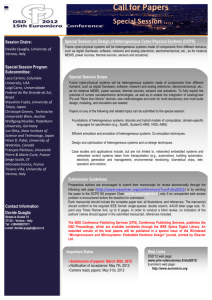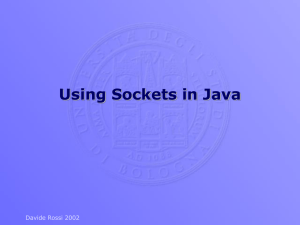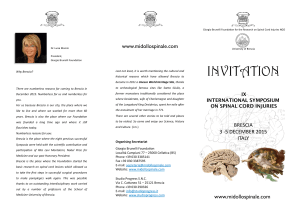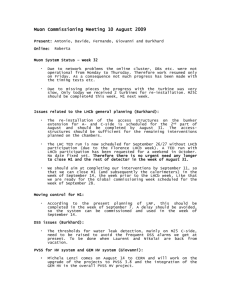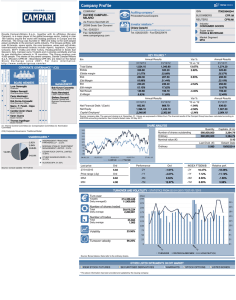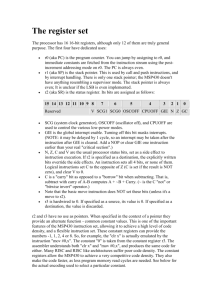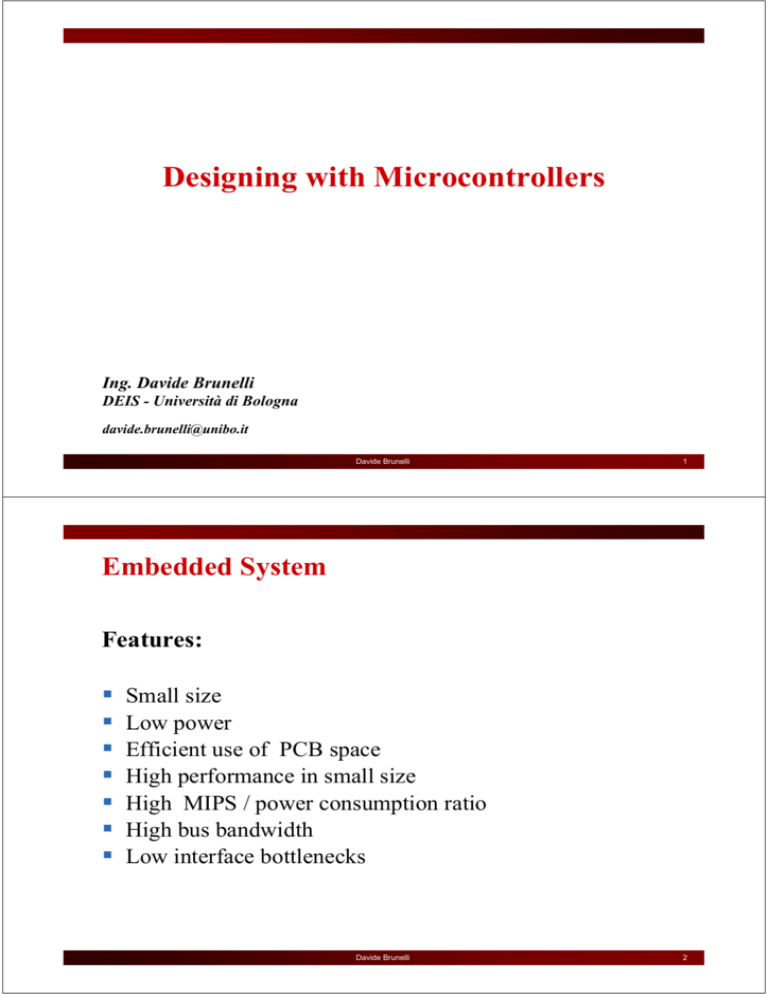
Designing with Microcontrollers
Ing. Davide Brunelli
DEIS - Università di Bologna
davide.brunelli@unibo.it
Davide Brunelli
1
Embedded System
y
F t
Features:
Small
S
ll size
i
Low power
Effi i t use off PCB space
Efficient
High performance in small size
Hi h MIPS / power consumption
High
ti ratio
ti
High bus bandwidth
Low interface bottlenecks
Davide Brunelli
2
Applications
pp
development
p
stages
g
Prototype
Goal: “Try it and see”
“Rapid
Rapid prototyping
prototyping”
Pilot
Goal: “Unprecedented data”
“Realistic
Realistic study
study”
“Modest scale”
“Modest investment”
“Well-enough executed”
Production
“Reducing cost”
“Optimizing
p
g performance”
p
“Improving manufacturability”
“Obtaining high reliability”
“Finalizing mechanicals”
+
Accrue
=
Learnings
Artifacts
Investments
Davide Brunelli
3
What is a microcontroller ?
A Microcontroller is a small CPU
with many support devices built into the chip
Self Contained (CPU, Memory, I/O)
Application
A li i or Task
T k Specific
S ifi (Not
(N a general-purpose
l
computer))
Appropriately scaled for the job
Small power consumption
Low costs ( $0.50 to $5.00.)
Davide Brunelli
4
Microcontrollers and Embedded Controllers
Controls some process or aspect of the environment:
Microcontrollers Vs. DSPs
DSPs optimized for math [multiplies]
(aÅa+b*c)
Embedded controller may not be a microcontroller per se
but is used for special purpose control application
Typical applications: temperature control, smart
instrument, GPS, digital lock, cell phone, etc. .
Davide Brunelli
5
Key Design Elements
Flash Storage
proc
data logs
pgm images
Data
SRAM
Sensor
Interface
timers
pgm
EPROM
Wireless Net
Interface
WD
Wired Net
Interface
Low-power
St db & Wakeup
Standby
W k
ADC
analog sensors
digital sensors
RF
transceiver
antenna
serial link
USB,EN,…
Efficient wireless protocol primitives
Fl ibl sensor iinterface
Flexible
t f
Ultra-low power standby
Very Fast wakeup
Watchdog and Monitoring
Data SRAM is critical limiting resource
Davide Brunelli
6
Examples
Personal information products: Cell phone, pager, watch,
pocket recorder, calculator
Laptop components: mouse, keyboard, modem, fax card,
sound card, battery charger
Home appliances: door lock, alarm clock, thermostat, air
conditioner, tv remote
conditioner
remote, hair dryer,
dryer VCR,
VCR small
refrigerator, exercise equipment, washer/dryer,
microwave oven
Toys; video games, cars, dolls, etc.
Davide Brunelli
7
Why Ultra-low
Ultra low Power Is Important
Longer battery life
Smaller products
Simpler power supplies
Less EMI simplifies
p
PCB
Permanent battery
Reduced liability
Davide Brunelli
8
Market & Families
Microcontroller unit sales are 15x higher than Microprocessors and are
much cheaper.
Most
M t manufacturers
f t
offer
ff a wide
id range off devices
d i
for
f low
l endd to
t higher
hi h
end applications
Out of scope
Davide Brunelli
9
Performance Metrics
Not easy to define.
Metrics are mostly application depended
Electrical:
El
ti l
Power Consumptions
Voltage Supply
Noise Immunity
Sensitivity
Computation:
Clock Speed
MIPS ((instructions pper sec))
Latency (lateness of the response)
- Lateness of the response
g between the begin
g and the
- Lag
end of the computation
Throughput
- Tasks per second
- Byte per second
Energy is a good
metric for the Digital
section of WSN node
Davide Brunelli
10
Microcontroller MSP430
Ultra-low Power
+
High Performance
High-Performance
0.1µA power down
0.8µA standby mode
250µA / 1MIPS
<1µs clock start-up
Zero-power BOR
<50nA pin leakage
Modern 16-bit RISC CPU
1K to 128KB+ ISP Flash
14- to 100-pin options
Intelligent peripherals boost
performance
Embedded
E b dd d emulation
l i
Davide Brunelli
11
MSP430 Roadmap
p
Device
5xx-Next Gen
Production
• 25 MIPS
• 32-256 KB
• USB-RF
Sampling
Development
Perform
mance
Future
F23x-F24x
F563x
USB
F261x
F241x
F543x
• 16 MIPS
120KB
• 11-120KB
• 500nA Stand By
F22xx
1xx-Catalog
• 8 MIPS
• 1-60KB
F21x1
F5xx RF
2xx-Catalog
F23x0
F20xx
F5xx
F21x2
F15x-F16x
F13x-F14x
F12xx
F/C11xx
Fx42x
F 42 0
Fx42x0
F/C41x
F471x7
Fx43x
F44x
F47x4
CG461x
FG461x
4xx-LCD
• 8/16 MIPS
• 4-120KB
• LCD Driver
F = Flash
C = Custom ROM
Integration
Davide Brunelli
12
MSP430 main characteristics
Flexibility:
Up to 256 kB
U
kByte Fl
Flash;
h
Up to 100 pins;
USART, I2C, Timers;
LCD driver;
Embedded emulation;
And many more peripherals modules…
Microcontroller
Mi
t ll performance:
f
Instruction processing on either bits, bytes or words
Reduced instructions set;
Compiler efficient;
Wide range of peripherals;
Flexible clock system.
Davide Brunelli
13
13
Microcontroller MSP430
16-BIT RISC with 27 core
instructions,27 emulated instuction, 7
addressing mode.
Modest clock speeds (8-16
(8 16 MHz)
16-bit bus(MAB E MDB), 16 GP 16bit registers fully addressable
Intended as “single
single chip”
chip solutions
In-circuit programmable Flash (~1000
cycles)
Small amount of FLASH and SRAM
Single-cycle execution of most
instructions
Several on-chip
on chip peripherals
(UART, SPI,I2C,IRDA, ADC(SAR &
Σ−Δ), 12 BITS DAC,PWM, 16 AND 8
BITS TIMERS,DMA
,
CONTROLLER,WDT, LDO)
Davide Brunelli
14
MSP430 architecture
Davide Brunelli
15
MSP430X16X Architecture
ADC
ALU
DAC
I/O Port
Registers
Interrupts
DMA
TIMERs
Davide Brunelli
USARTx
16
Memory organization
The MSP430 von-Neumann architecture has
one address space shared with special
function registers (SFRs), peripherals,
RAM, and Flash/ROM memory. Data
can be accessed as bytes or words.
Th addressable
The
dd
bl memory space is
i 64 KB.
KB
17
Davide Brunelli
17
Address Space
Mapped into a single, contiguous address space:
All memory, including RAM, Flash/ROM, information memory,
special
p
function registers
g
(SFRs),
(
) and pperipheral
p
registers.
g
Memory Address
0FFFFh
End:
Start:
0FFE0h
End:
0FFDFh
Memory
e o y Map:
ap:
Description
Interrupt Vector Table
Flash/ROM
Start *:
End *:
Start:
End:
Start:
End *:
Start:
End:
Start:
End:
Start:
End:
Start:
0F800h
01100h
010FFh
0107Fh
01000h
0FFFh
0C00h
09FFh
027Fh
0200h
01FFh
0100h
00FFh
0010h
000Fh
0000h
Davide Brunelli
Information Memory
(Flash devices only)
Boot Memory
(Flash devices only)
RAM
Access
Word/Byte
Word/Byte
y
Word/Byte
Word/Byte
Word/Byte
16-bit Peripheral modules
Word
8-bit Peripheral modules
Byte
Special Function Registers
Byte
18
18
Addressing modes
7 addressing modes for the source operand:
4 addressingg modes for the destination operand:
p
Register mode; Indexed mode; Symbolic mode; Absolute mode.
For the destination operand, two additional addressing modes can be
emulated.
Davide Brunelli
19
19
Registers and IS
16 general-purpose 16-bit
registers (R0 to R15).
INSTRUCTION SET (f
(for msp430f1612):
430f1612)
51(coreand emulated) INSTRUCTION WITH
3 FORMATAND 7 ADDRESS MODES.
20
Davide Brunelli
20
Internal Registers
Program
g
Counter (PC)
Points to the next instruction to be executed
Stack Pointer (SP)
Store the return addresses of subroutine calls and interrupts
p
Status Register (SR)
Source or destination register
Davide Brunelli
21
Interrupt vector table
Mapped at the very end of memory space (upper 16
words of Flash/ROM): 0FFE0h - 0FFFEh (4xx
devices);
Priority of the interrupt vector increases with the
word address.
Copyright 2009 Texas Instruments
All Rights Reserved
Davide Brunelli
www.msp430.ubi.pt
22
How to Read Datasheets
Manufacturers of electronic components provide datasheets
containing
i i the
h specifications
ifi i
detailing
d ili the
h part/device
/d i
characteristics;
Datasheets give the electrical characteristics of the device and the
pin out functions,
pin-out
functions but without detailing the internal operation;
More complex devices are provided with documents that aid the
development of applications, such as:
Application notes;
User's guides;
Designer's guides;
Package drawings, etc…
Davide Brunelli
23
How to Read Datasheets
MSP430 device datasheet:
Device has a large number of peripherals;
Each input/output
p
p ppin usuallyy has more than one function;;
It has a table with the description of each pin function;
Example Pin number 2 = P6.3/A3;
Example,
P6 3/A3;
- Digital Input/Output Port 6 bit 3;
- 3rd analogue input.
Davide Brunelli
24
How to Read Datasheets
MSP430 User’s Guide:
Most peripherals are represented by Block Diagrams.
Example:
p Part of the MSP430F44x clock module block diagram:
g
Davide Brunelli
25
Clock System
One DCO, internal digitally controlled
oscillator
ill t
Generated on-chip RC-type
frequency controlled by SW + HW
One LF/XT oscillator
LF: 32768Hz
XT: 450kHz .... 8MHz
Second LF/XT2 oscillator
Optional XT: 450kHz .... 8MHz
Clocks:
ACLK auxiliary clock ACLK
MCLK main system clock MCLK
SMCLK sub
b main
i system
t clock
l k
Davide Brunelli
26
Basic Clock System
Basic Clock Module
provides the clocks for the
MSP430 devices
Davide Brunelli
27
System Clock: details
DIVA
2
LFXTCLK
/1, /2, /4, /8
OscOff
XTS
ACLKGEN
ACLK
Auxiliary Clock
SELM DIVM CPUOff
High frequency
2
Vcc
0
P2.5
/R
/Rosc
0,1
Low power
Vcc LF oscillator, XTS=0
Rsel SCG0
1
DCOR
DCGenerator
DCGEN
2
3
XT oscillator, XTS=1
2
DCO
MOD
3
5
/1 /2,
/1,
/2 /4,
/4 /8,
/8 off
ff
MCLK
MCLKGEN
Main System Clock
SELS DIVS SCG1
DCOCLK
2
Digital Controlled Oscillator DCO
0
Modulator MOD
1
DCOMOD
SMCLK
/1, /2, /4, /8, off
+
SMCLKGEN
Sub-System Clock
The DCO-Generator is connected to pin P2.5/Rosc if DCOR control bit is set.
The port pin P2.5/Rosc is selected if DCOR control bit is reset (initial state).
Davide Brunelli
28
System Clock
Internal clock signals:
Both MCLK and SMCLK are sourced from DCOCLK at ~1.1 MHz but
can be sourced up to 16 MHz;
DCO frequency
Calibration register
Size
Address
1 MHz
CALBC1_1MHZ
CALBC1
1MHZ
CALBC0_1MHZ
Byte
Byte
010FFh
010FEh
8 MHz
CALBC1_8MHZ
CALBC0_8MHZ
Byte
Byte
010FDh
010FCh
12 MHz
CALBC1_12MHZ
CALBC0_12MHZ
Byte
Byte
010FBh
010FAh
16 MHz
CALBC1_16MHZ
CALBC0 16MHZ
CALBC0_16MHZ
Byte
B t
Byte
010F9h
010F8h
Davide Brunelli
29
System Clock
Internal clock signals:
Electrical characteristics vary over the recommended supply voltage range
of between 2.2 V and 3.6 V. Higher DCO frequencies require higher supply
voltages.
Typical characteristics in active mode supply current for the
Davide Brunelli
30
Digital I/O
Independently programmable
individual I/Os
•
Up to 6 ports (P1 – P6)
•
Each has 8 I/O pins
•
Each pin can be configured
as input or output
•
P1 and P2 pins can be
configured to assert an
interrupt request
Port1
Port2
Port3
…
Port6
Function Select Register PxSEL
yes
yes
Interrupt Edge Select Register PxIES
yes
no
Interrupt Enable Register PxIE
yes
no
yes
no
Direction Register PxDIR
yes
yes
Output Register PxOUT
yes
yes
yes
yes
Interrupt Flag Register PxIFG
Input Register PxIN
P1.
P2.
7
P3.
6
5
4
3
2
1
0
P4.
P5.
P6.
Davide Brunelli
31
GPIO - Inputs
p
Avoid floating inputs!!!
Use a pull-up/down resistor, GND,
or internal programmable logic
To Input
p Logic
g
VCC
Button
5.6KΩ
Button produces
either Vcc
or Floating input.
Adding a pull-down
resistor fixes it.
Davide Brunelli
VCC
Button
Port Pin
5.6KΩ
Some ports have internal
programmable resistors
32
GPIO - Outputs
p
Open-collector
Many logic chips, output pins, circuits use open-collector
(open-drain)
Simple logic-glue, signal bus
Wired-OR
Wired
OR circuits
Interface
I t f
different
diff
t voltage
lt
levels.
l l
I t f
Interface
between
b t
5V CMOS logic
l i andd a higher
hi h voltage
lt
Davide Brunelli
33
Davide Brunelli
34
G O
GPIO
Inside Inputs/Outputs
z
Each pin is independent
Ports (out) and Pins (in) are not the
same thing!!
z
Output section
Input section
External Memoryy Access
Davide Brunelli
35
Interrupts
p
Main Prog
A way to respond to an external event (i.e.,
flag being set) without polling
How it works:
H/W senses flag being set
Automatically
A tomaticall transfers control to s/w
s/ that
“services” the interrupt
When done, H/W returns control to
wherever it left off
ISR
:
:
:
:
RETI
Advantages:
Transparent to user
cleaner code
μC doesn
doesn’tt waste time polling
Davide Brunelli
36
Interrupts: details
3 types
System reset
(Non)-maskable NMI
Maskable
Interrupt priorities
are fixed and defined
by the arrangement
of modules
Davide Brunelli
37
(Non) Maskable Interrupts
(Non)-Maskable
Sources
S
An edge on the RST/NMI pin when configured in NMI
mode
An oscillator fault occurs
An access violation to the flash memoryy
Are not masked by GIE (General Interrupt
Enable), but are enabled by individual interrupt
enable bits (NMIIE, OFIE, ACCVIE)
Davide Brunelli
38
NMI Interrupt Handler
Davide Brunelli
39
Maskable Interrupts
Caused by peripherals with interrupt capability
Each can be disabled individually by
an interrupt enable bit
All can be disabled by GIE bit in the status register
Davide Brunelli
40
Interrupt acceptance
1)) Any
y currentlyy executingg instruction is completed.
p
2) The PC, which points to the next instruction, is pushed onto the stack.
3) The SR is pushed onto the stack.
4) The interrupt with the highest priority is selected if multiple interrupts occurred
during the last instruction and are pending for service.
5) The interrupt request flag resets automatically on single-source
single source flags.
flags Multiple source
flags remain set for servicing by software.
6) The SR is cleared with the exception of SCG0, which is left unchanged. This
terminates any low-power mode. Because the GIE bit is cleared, further interrupts
are disabled.
7) The content of the interrupt vector is loaded into the PC: the program continues with
Takes 6 cc to execute
the interrupt service routine at that address.
Davide Brunelli
41
Return from Interrupt
RETI - Return from Interrupt Service Routine
1) The SR with all previous settings pops from the stack. All
previous settings of GIE, CPUOFF, etc. are now in effect,
regardless of the settings used during the interrupt service
routine.
2) The PC pops from the stack and begins execution at the
point where it was interrupted.
Takes 5 cc to execute
Davide Brunelli
42
Interrupt Vectors
/************************************************************
* Interrupt Vectors (offset from 0xFFE0)
/
************************************************************/
#define PORT2_VECTOR
1 * 2
/* 0xFFE2 Port 2 */
#define UART1TX
UART1TX_VECTOR
VECTOR
2 * 2
/*
/ 0xFFE4 UART 1 Transmit */
/
#define UART1RX_VECTOR
3 * 2
/* 0xFFE6 UART 1 Receive */
#define PORT1_VECTOR
4 * 2
/* 0xFFE8 Port 1 */
#d fi
#define
TIMERA1_VECTOR
TIMERA1 VECTOR
5 * 2
/* 0
0xFFEA
FFEA Ti
Timer A CC1
CC1-2,
2 TA */
#define TIMERA0_VECTOR
6 * 2
/* 0xFFEC Timer A CC0 */
#define ADC_VECTOR
7 * 2
/* 0xFFEE ADC */
#define UART0TX_VECTOR
8 * 2
/* 0xFFF0 UART 0 Transmit */
#define UART0RX_VECTOR
9 * 2
/* 0xFFF2 UART 0 Receive */
#define WDT_VECTOR
10 * 2 /* 0xFFF4 Watchdog Timer */
#define COMPARATORA_VECTOR
11 * 2 /* 0xFFF6 Comparator A */
#define TIMERB1_VECTOR
12 * 2 /* 0xFFF8 Timer B 1-7 */
#define TIMERB0_VECTOR
13 * 2 /* 0xFFFA Timer B 0 */
#define NMI_VECTOR
14 * 2 /* 0xFFFC Non-maskable */
#define RESET_VECTOR
15 * 2 /* 0xFFFE Reset [Highest Pr.] */
Davide Brunelli
43
Interfaces
Several pprotocols for inter-chipp communication
UART, I2C, SPI, USB,…
Serial communication protocols
Meant for short distances “inside the box”
Low complexity
L cost
Low
Low speed ( a few Mbps at the fastest )
S i l communication
Serial
i ti is
i employed
l d where
h it is
i nott practical,
ti l
either in physical or cost terms, to move data in parallel
between systems.
Davide Brunelli
44
I2C
Shorthand for an “Inter-integrated circuit” bus
I2C devices include EEPROMs, thermal sensors, and realtime clocks
Used as a control interface to signal processing devices that
have separate data interfaces, e.g. RF tuners, video decoders
and encoders, and audio processors.
I2C bus has three speeds:
Slow (under 100 Kbps)
Fast (400 Kbps)
High-speed (3.4 Mbps) – I2C v.2.0
Limited to about 10 feet for moderate speeds
Davide Brunelli
45
I2C Bus Configuration
22-wire
wire serial bus – Serial data (SDA) and Serial clock (SCL)
Half-duplex, synchronous, multi-master bus
No chip select or arbitration logic required
Lines pulled high via resistors,
resistors pulled down via open-drain
open drain drivers
(wired-AND)
Davide Brunelli
46
I2C Features
“Clock stretching” – when the slave (receiver) needs more time to
process a bit, it can pull SCL low. The master waits until the slave
has released SCL before sending the next bit.
“General call” broadcast – addresses every device on the bus
10-bit extended addressing for new designs. 7-bit addresses all
exhausted
Start
Direction
Data bits
Address bits
Receiver Ack
Stop
Davide Brunelli
47
Davide Brunelli
48
Example
p
I2C bridge
SPI
Shorthand for “Serial Peripheral Interface”
Defined by Motorola on the MC68HCxx line of
microcontrollers
Generally faster than I2C,
C capable of several Mbps
Applications:
Like I2C, used in EEPROM, Flash, and real time clocks
Better suited for “data streams”, i.e. ADC converters
Full duplex capability, i.e. communication between a codec and
digital signal processor
Davide Brunelli
49
SPI Bus Configuration
g
Synchronous serial data link operating at full duplex
Master/slave relationship
2 data signals:
MOSI – master data output, slave data input
MISO – master data input, slave data output
2 control signals:
SCLK – clock
/SS – slave
l
select
l t
(no
( addressing)
dd
i )
Davide Brunelli
50
SPI
As the register transmits the byte to the slave on the
MOSI signal
i l line,
li the
th slave
l
transfers
t
f the
th contents
t t off its
it
shift register back to the master on the MISO signal
line exchanging the contents of the two shift registers
line,
registers.
Davide Brunelli
51
SPI vs. I2C
For ppoint-to-point,
p
, SPI is simple
p
and efficient
Less overhead than I2C due to lack
of addressing, plus SPI is full
duplex.
SPI
For multiple slaves, each slave
needs separate slave select signal
More effort and more hardware
than I2C
I2C
Davide Brunelli
52
UART
Shorthand for “Universal Asynchronous ReceiverTransmitter
i
“
A UART’s
UART s transmitter is essentially just a parallel-to-serial
parallel to serial
converter with extra features.
The essence of the UART transmitter is a shift register that is
loaded in parallel, and then each bit is sequentially shifted out
of the device on each p
pulse of the serial clock.
One of the problems associated with serial transmission is
reconstructing
i the
h data
d at the
h receiving
i i end.
d
Difficulties arise in detecting boundaries between bits
bits.
Davide Brunelli
53
UART
Asynchronous serial devices, such as UARTs, do not share a
common clock
Each device has its own,
own local clock.
clock
The devices must operate at exactly the same frequency.
Logic (within the UART) is required to detect the phase of the
transmitted data and phase lock the receiver’s clock to this.
Bitrate:
Bit t 2400,
2400 19200,
19200 57600,115200,
57600 115200 921600…
921600
Davide Brunelli
54
UART
The transmission format uses one start bit at the
beginning and one or two stop bits end of each
character.
h
t
Davide Brunelli
55
RS232C
An old standard (1960), originally intended for connecting
computer equipment (computers or terminals, referred to
as DTE) to communication equipment (DCE).
RS232C is are commonly used in conjunction with UART
because they share the same protocol
RS232 Voltages are +5..+25V for a logic 0, and -5V..-25V
for a logic
g 1 ((Reverse ppolarity)
y)
Davide Brunelli
56
USART Block Diagram:
g
UART mode
Davide Brunelli
57
RS 232 Interface Standard
RS-232
DB-25 connector is described in the book;
let’s take a look at DB-9
Davide Brunelli
58
Implementing
p
g RS-232C
Davide Brunelli
59
ADC conversion
Sample and Hold
Ve is a mapping R → R
: Discretization of time
Restriction to digital information processing.
Known digital computers can only process discrete time series
Sample and hold-devices.
Ideally: width of clock pulse → 0
Vx is a sequence of values or a mapping Z → R
Davide Brunelli
60
A/D-converters
Flash A/D converter
Digital computers require digital form of physical values )A/D-conversion;
An Analog to Digital Converter (ADC) converts an analog input voltage to a digital
number
number.
Many methods with different speeds.
Example: 1. Flash A/D converter:
Parallel comparison
p
with
reference voltage
Speed: O(1)
Hardware complexity: O(n)
with n= # of distinguished
g
voltage levels
Davide Brunelli
61
A/D-converters
Successive approximation
Key idea: binary search:
Set MSB
MSB='1'
1
if too large: reset MSB
Set MSB-1='1'
if too
t large:
l
resett MSB-1
MSB 1
Speed: O(ld(n))
Hardware
d
complexity:
l i O(ld(n))
(ld( ))
with n= # of distinguished voltage levels;
slow, but high accurate
Davide Brunelli
62
ADC on MSP430
The ADC12 module supports fast, 12-bit analog-to-digital conversions.
Features:
• G
Greater
t th
than 200 kksps maximum
i
conversion rate
• Monotonic 12-bit converter with no
missingg codes
• Sample-and-hold with
programmable sampling periods
controlled by software or timers
• Software selectable on-chip
reference voltage generation (1.5 V
or 2.5 V)
• Interrupt vector register for fast
decoding of 18 ADC interrupts
• 16 conversion-result storage registers
Davide Brunelli
63
Davide Brunelli
64
Timer A
Timer_A
Timer_A is a 16-bit
timer/counter with three
capture/compare registers
•
Capture external signals
•
•
Compare PWM mode
SCCI latch for asynchronous
communication
Timer A 16-bit
Timer_A
16 bit Counter
15
0
TACTL
Input
Select
unused
160h
rw(0)
rw(0)
rw(0)
rw(0)
rw(0)
rw(0)
rw(0)
rw(0)
SSEL1 SSEL0
0
0
0
1
1
0
1
1
Input
p
Divider
rw(0)
Mode
Control
rw(0)
ID1
ID0
0
0
1
1
0
1
0
1
unTAIE TAIFG
used CLR
rw(0)
rw(0)
rw(0)
MC1
MC0
0
0
1
1
0
1
0
1
(w)(0)
rw(0)
rw(0)
Stop Mode
Up Mode
Continuous Mode
Up/Down Mode
1/1, Pass
1/2
1/4
1/8
TACLK
ACLK
MCLK
INCLK
Davide Brunelli
65
Timer A - Counting Modes
Timer_A
Stop/Halt Mode
UP/DOWN Mode
Timer is halted with the next +CLK
Timer counts between 0 and CCR0 and 0
0FFFFh
UP/DOWN Mode
CCR0
0h
UP Mode
Continuous Mode
Timer counts between 0 and CCR0
Timer continuously counts up
0FFFFh
Continuous Mode
0FFFFh
CCR0
0h
0h
Davide Brunelli
66
Timer A – Waveform generator
Timer_A
UP M
Mode
d
Timer counts between 0 and CCR0
Davide Brunelli
67
Davide Brunelli
68
Comparator A
Comparator_A
Comparator_A
Comparator
A is an analog
voltage comparator
•
Supports precision slope
analog-to-digital
g
g
conversions
•
Supply voltage supervision,
and
•
Monitoring of external
analog signals.
Watchdog Timer
General
Th primary
The
i
function
f ti off the
th watchdog-timer
t hd ti
module
d l (WDT) iis tto perform
f
a controlledt ll d
system restart after a software problem occurs. If the selected time interval expires, a
system reset is generated. If the watchdog function is not needed in an application, the
module can work as an interval timer, to generate an interrupt after the selected time
interval.
Features of the Watchdog
g Timer include:
¾ Eight software-selectable time intervals
¾ Two operating modes: as watchdog or interval timer
¾ Expiration of the time interval in watchdog mode,
mode which generates a system reset; or
in timer mode, which generates an interrupt request
¾ Safeguards which ensure that writing to the WDT control register is only possible
g a password
p
using
¾ Support of ultralow-power using the hold mode
Watchdog/Timer two functions:
¾ SW Watchdog Mode
¾ Interval Timer Mode
69
Davide Brunelli
69
Davide Brunelli
70
Watchdog Timer
WDT module performs a
controlled system restart after a
software
ft
problem
bl occurs
•
Can serve as an interval timer
(generates interrupts)
•
WDT Control register is
password protected
•
Note: Powers-up active
DMA
Di t Memory
Direct
M
A
Access
(DMA)
The MSP430 has been designed for applications requiring low power;
When the application requires data-handling, the direct memory access (DMA)
capability
bilit included
i l d d in
i some devices
d i
i useful:
is
f l
DMA automaticallyy handles data;;
DMA does not require CPU intervention;
DMA helps reduce the power consumption (CPU remains sleeping).
Davide Brunelli
71
DMA
Concept of DMA: move functionality to peripherals:
Peripherals use less current than the CPU;
Delegating
g
g control to pperipherals
p
allows the CPU to shut down ((saves
power);
“Intelligent”
te ge t peripherals
pe p e a s are
a e more
o e capable,
capab e, providing
p ov d g a better
bette opportunity
oppo tu ty for
o
CPU shutoff;
DMA can be enabled for repetitive data handling, increasing the throughput
of peripheral modules;
Minimal software requirements and CPU cycles.
Davide Brunelli
72
DMA
Block diagram:
Davide Brunelli
73
Power as a Design
g Constraint
Why worry about power?
Battery life in portable and mobile platforms
Power consumption in desktops, server farms
- Cooling costs, packaging costs, reliability, timing
- Power density: 30 W/cm2 in Alpha 21364
(3x of typical hot plate)
Wh
Where
d
does power go iin CMOS?
Dynamic power
consumption
Power due to shortPower due to
circuit current
leakage current
during transition
P = ACV 2f + τAVIshort f + VIleak
Davide Brunelli
74
Dynamic
y
Power Consumption
p
C – Total capacitance
seen by
b th
the gate’s
t ’ outputs
t t
Function of wire lengths,
transistor sizes, ...
V – Supply
pp y voltage
g
Trend: has been dropping
with each successive fab
ACV 2f
A - Activity of gates
How often on average do
wires switch?
f – clock frequency
Trend: increasing ...
Reducing Dynamic Power
1)
Reducing V has quadratic effect; Limits?
2)
Lower C - shrink structures, shorten wires
3)
Reduce switching activity - Turn off unused parts or
use design techniques to minimize number of transitions
Davide Brunelli
75
Short circuit Power Consumption
Short-circuit
τAVIshort f
Vin
Ishort
Finite slope of the input signal
causes a direct current path
b
between
VDD andd GND ffor a
Vout short period of time during
switching when both the NMOS
CL
and PMOS transistors are
conducting
Reducing Short-circuit
1)
Lower the supply voltage V
2)
Slope engineering – match the rise/fall time of the input and output signals
Davide Brunelli
76
Leakage
g Power
VIleak
Sub-threshold
currentt
Sub-threshold current ggrows exponentially
p
y with
increases in temperature and decreases in Vt
Davide Brunelli
77
How can we reduce
power consumption?
Dynamic power consumption
Reduce the rate of charge/discharge of highly loaded nodes
Reduce spurious switching (glitches)
Reduce switching in idle states (clock gating)
Decrease frequency
Decrease voltage (and frequency)
Static power Consumption
Smaller area (!)
Reduce device leakage through power gating
Reduce device leakage through body biasing
Use higher-threshold transistors when possible
Power performance tradeoffs!
Davide Brunelli
78
Operating Modes
Davide Brunelli
79
C Examples - Operating Modes
C – programming
i
msp430x14x.h
430 14 h
/************************
* STATUS REGISTER BITS
************************/
#define C
0x0001
#define Z
0x0002
#define N
0x0004
#define V
0x0100
#define GIE
0x0008
#define CPUOFF 0x0010
#define OSCOFF 0x0020
#define SCG0
0x0040
#define SCG1
0x0080
/* Low Power Modes coded with
Bits 4-7 in SR */
/* B
Begin
i #d
#defines
fi
f
for assembler
bl
*/
#ifndef __IAR_SYSTEMS_ICC
#define LPM0
CPUOFF
#define LPM1
SCG0+CPUOFF
#define LPM2
SCG1+CPUOFF
#define LPM3
SCG1+SCG0+CPUOFF
#define LPM4
SCG1+SCG0+OSCOFF+CPUOFF
/* End #defines for assembler */
#else /* Begin #defines for C */
#define LPM0_bits
CPUOFF
#define LPM1
LPM1_bits
bits
SCG0+CPUOFF
#define LPM2_bits
SCG1+CPUOFF
#define LPM3_bits
SCG1+SCG0+CPUOFF
#define LPM4_bits
SCG1+SCG0+OSCOFF+CPUOFF
…
#include "In430.h“
#define LPM0
_BIS_SR(LPM0_bits)
#define LPM0_EXIT _BIC_SR(LPM0_bits)
#define LPM1
_BIS_SR(LPM1_bits)
#define LPM1_EXIT _BIC_SR(LPM1_bits)
#define LPM2
_BIS_SR(LPM2_bits)
#define LPM2_EXIT _BIC_SR(LPM2_bits)
#define LPM3
_BIS_SR(LPM3_bits)
#define LPM3_EXIT _BIC_SR(LPM3_bits)
#define LPM4
_BIS_SR(LPM4_bits)
BIS SR(LPM4 bits)
#define LPM4_EXIT _BIC_SR(LPM4_bits)
#endif /* End #defines for C */
/*Enter LP Mode 0*/
/*Exit LP Mode 0*/
/*Enter LP Mode 1*/
/*Exit LP Mode 1*/
/*Enter LP Mode 2*/
/*Exit LP Mode 2*/
/*Enter LP Mode 3*/
/*Exit LP Mode 3*/
/
/*Enter
Enter LP Mode 4*/
4 /
/*Exit LP Mode 4*/
/* - in430.h Intrinsic functions for the MSP430
*/
unsigned short _BIS_SR(unsigned short);
unsigned short _BIC_SR(unsigned short);
Davide Brunelli
80
What we mean by “Low Power”
2 AA Æ 1.5 amp hours (~4 watt hours)
Cell Æ 1 amp hour (3.5 watt hours)
C ll 500 -1000
Cell:
1000 mW
W
Æ few
f hhours active
ti
WiFi: 300 - 500 mW
Æ several hours
GPS: 50 – 100 mW
Æ couple days
WSN: 50 mW active,, 20 uW passive
p
450 uW Æ one year
45 uW Æ ~10 years
Ave Power = fact * Pact + fsleep * Psleep + fwaking * Pwaking
Davide Brunelli
81
Node Power States
Active
Active
Sleep
WakeUP
Work
Davide Brunelli
Sleep
WakeUP
Work
82
Average power consumption
Dynamic power supply current
Set of modules that are periodically active
Typical situation – real time cycle T
Iave = ∫ Icc(t)dt /T
In most cases Iave = Σ Ii*ti/T
Icc (power supply current)
Time
T
Davide Brunelli
83
Basic Conditions for Burst Mode
The
ee
example
a peo
of the
e heat
ea cos
cost allocator
a oca o sshows
o s that
a the
e cu
current
e o
of the
e non-activity
o ac
y pe
periode
ode
dominates the current consumption.
Measure
IAVG = IMeasure
Process data
+ ICalculate
= IADC* t Measure/T + Iactive * tcalc /T
Real-Time Clock
LCD Display
+ IRTC
+
IDisplay
+ Iactive * tRTC /T
+
IDisplay
= 3mA *200µs/60s
+ 0.5mA * 10ms/60s + 0.5mA * 0.5ms/60s
+
21µA
= 10nA
+ 83nA
+
21µA
+ 4nA
IAVG ≅
21µA
The sleep
p current dominates the current consumption!
p
The currents are related to the sensor and μC system. Additional current consumption of other
y
p
parts should be added for the total system
y
current
system
Davide Brunelli
84
Battery Life
B
Battery C
Capacity
i BC – [mAh]
[ Ah]
Battery Life
BL = BC / Iave
In the previous example, standard 750 mAh batteries
will allow battery life of:
BL = 750 mAh / 21 μA ≈ 4.2 years !!!
Conclusion:
Power efficient modes
Interrupt
I t
t driven
di
system
t with
ith processor in
i idle
idl mode
d
Davide Brunelli
85
Minimizingg power
p
in SW: Basics
• System clock to maximize the time in LPM3 (LPM3 power consumption is
less than 2 µA typical with both a real-time
real time clock function and all interrupts active)
• 32-kHz watch crystal for ACLK; CPU clocked from the DCO
• Interrupts to wake the processor and control program flow
• Peripherals
P i h l should
h ld be
b switched
i h d on only
l when
h needed
d d
• Use low-power integrated peripheral modules in place of software
driven functions. (i.e. example Timer_A and Timer_B can automatically generate PWM
and capture external timing, with no CPU resources)
• Branching and fast table look-ups in place of flag polling and long
software calculations
• Avoid frequent subroutine and function calls due to overhead
Davide Brunelli
86
Programming
g
g a Microcontroller
Davide Brunelli
87
Projecting
j
g flow
Design Decisions
Davide Brunelli
How to read inputs?
How often to read inputs?
p
Which order to read the
inputs?
How to compute
p
responses?
How to generate the
responses?
How often to generate?
88
MSP430 programming
IAR Embedded Workbench
Integrated tools in this IDE are:
Compiler
C
il IAR MSP430 C/C++;
C/C
Assembler IAR MSP430;
IAR XLINK Linker™;
The IAR XAR Library Builder™;
Text editor;
Project management;
Command lines utility;
IAR C-SPY™ debugger.
Gives the user:
A highly efficient IDE;
Functional workspace methodology;
Reduced development time.
Copyright 2009 Texas Instruments
All Rights Reserved
Davide Brunelli
89
89
eZ430-F2013
eZ430
F2013 Development Tool
Complete development tool that fits in your pocket
Supports
S
t MSP430F20xx
MSP430F20 devices
d i
only
l
MSP430F20xx devices available in DIP
Unrestricted programming and debugging
Fast,
Fast easy to use operation
Includes IAR Kickstart IDE
Supported by CCE V2
Davide Brunelli
90
EZ430 RF2500
EZ430-RF2500
USB-based MSP430 wireless development tool to evaluate the
MSP430F2274 microcontroller
i
ll andd CC2500 2.4-GHz
2 4 GH wireless
i l
transceiver;
Able
Abl tto remotely
t l send
d and
d receive
i ddata
t ffrom a PC using
i the
th
MSP430 Application UART.
Copyright 2009 Texas Instruments
All Rights Reserved
Davide Brunelli
www.msp430.ubi.pt
91
91
EZ430-RF2500
Device features and integrated peripherals:
16 MIPS performance;
16-MIPS
f
200-kbps 10-bit SAR ADC;
Two built-in Op-Amps;
Watchdogg timer,, 16-bit Timer_A3 and Timer_B3;;
USCI module supporting UART/LIN, (2) SPI, I2C, or IrDA;
5 low-power
low power modes (700 nA in standby);
2.4-GHz radio-frequency (RF) transceiver;
Programmable data rate up to 500 kbps;
Low current consumption.
Copyright 2009 Texas Instruments
All Rights Reserved
Davide Brunelli
www.msp430.ubi.pt
92
92
USB Flash Emulation Tool (FET)
MSP430 FET: real-time debug and programming tool
Supports ALL MSP430 devices
44-wire
wire JTAG
2-wire Spy Bi-Wire
Available
A il bl with
ith socketed
k t d target
t
t board
b d
Example: MSP-FET430U14 = FET Interface + 14-pin target board
Supported by all MSP430 IDEs
Davide Brunelli
93
Embedded Emulation
Real-time in-system debug
No application resources used
Full speed execution
H/W breakpoints
Single
g stepping
pp g
Complex triggering
Trace capability
Easy to use tools
l
Spy Bi-Wire
2-wire debug interface
No pin function impact
JTAG
Davide Brunelli
94
Downloading Code
The MSP430 uses internal flash memory for program storage.
This can be programmed (reprogrammed) in-circuit.
The MSP430 processors are programmed via a JTAG port on the chip .
The pins TDI, TDO, TMS, TCLK and RST of JTAG interface are
used for programming and testing ends.
95
Davide Brunelli
95
Data Representation
2-complement
!
Davide Brunelli
96
Instruction Set
• 27 core instructions and 24 emulated instructions
• 3 core
core-instruction
instruction formats: (i) Dual-operand,
Dual operand (ii) Single
Singleoperand, (iii) Jump
Davide Brunelli
97
Code structuring
Typical
T i l structure
t t
off a simple
i l embedded
b dd d Software
S ft
Initialize devices… (UART, SPI, TIMER, etc…)
[Clear registers,
g
read values from
f
Eeprom]
p
…
loop
inputs/sensors;
p response;
p
compute
generate actuator outputs
read
Forever
Davide Brunelli
98
System Reset / Initialization
Init Cond After System Reset
Software Initialization
After a POR, the initial MSP430
conditions are:
After a system reset initialize
for application requirements:
• RST/NMI pin in the reset mode
• Initialize
t a e the
t e SP
S to top of
o the
t e
• I/O pins in input mode
RAM
• peripheral modules/registers as default
• Initialize watchdog
• Status register (SR) is reset.
reset
• Configure peripheral modules
• Watchdog timer powers up in wd
mode
• Program counter (PC) loaded with
address contained at reset vector
location (0FFFEh). CPU execution
begins at that address.
Davide Brunelli
99
Which programming language…?
Generally a high-level language like C will be the
language of choice.
choice
developing software is much easier
your code
d is
i also
l portable
t bl between
b t
different
diff
t target
t
t
machines.
So why use assembly?
Davide Brunelli
100
Why use assembly?
Assembly and machine code, because they are “hand-written”, can be finely
tuned to get the most performance out of the processor and computer
hardware.
This can be particularly important when dealing with time-critical
operations with I/O devices.
Coding directly in assembly can often (but not always) result in a smaller
code space.
The drawback is that the software is harder to maintain and has zero
portability to other processors.
Davide Brunelli
101
Syntax - General
Each line of a program is one of the following:
an instruction
an assember directive (or pseudo-op)
a comment
Whitespace and case (between symbols) are ignored.
Comments (beginning with “;”)
; ) are also ignored.
ignored
An instruction has the following format:
LABEL OPCODE OPERANDS ; COMMENTS
optional
mandatory
Davide Brunelli
102
Syntax - Opcodes and Operands
Opcodes
O d
reserved symbols that correspond to LC-3 instructions
- ex: ADD, AND, LD,…
Operands
registers -- specified by Rn, where n is the register number
numbers -- indicated by # (decimal) or x (hex)
label -- symbolic name of memory location
separated by comma
number, order, and type correspond to instruction format
- ex:
Davide Brunelli
103
Syntax – Label and Comment
Label
placed at the beginning of the line
assigns
g a symbolic
y
name to the
address corresponding to line
Comment
anything after a semicolon is a comment
ignored by assembler
used by humans to
p g
document/understand programs
tips for useful comments:
- avoid restating the obvious, as “decrement R1”
- provide additional insight
insight, as in “accumulate
accumulate product in R6”
R6
- use comments to separate pieces of program
Step 3: Planning project
and write code
Davide Brunelli
104
How to organize the code
1 Header
1.
H d
1. Include
1. Register
1 Interrupt
1.
Davide Brunelli
105
C - Programming Issues
C programming language:
C is an algorithmic language;
C was developed for operating systems;
It is based on expressions;
An expression can be the result of an operation or a function;
The program flow
Th
fl control
t l is
i achieved
hi d using
i a sett off appropriate
i t structures
t t
that enable the choice, based on a logic operation, of the sequence of
operations to be performed by the CPU;
These structures allow cyclic execution of expressions that compose a block
g
of pprogram.
Davide Brunelli
106
Programming Issues
Declaration of variables:
Must always be made at the beginning of a program;
Global
G
ob vvariables:
b es: Accessible
ccess b e throughout
oug ou thee code;
Local variables: declared within one function and are only
accessible during the execution of this function;
If a variable is declared within a program block, it is only accessible
while the flow of the program is underway within the block.
block
Davide Brunelli
107
Programming Issues
Identifiers names:
const:
-
extern:
-
Used to declare a constant (content is not changed in the course of code
implementation);
Stored in program section memory.
Used to make reference to variables declared elsewhere, for example in
another module.
register:
-
Used to store a variable in a processor’s register;
Promotes faster access to the contents of the variable;
Only used locally and depends on the register’s availability.
Davide Brunelli
108
Programming Issues
Identifiers names:
static:
-
Function declared within a function or a program block;
Resources occupied are released, and with them their contents;
Preserves the variable even after a function or block has been executed.
volatile:
-
Used if an event outside the program can change the content of a variable, for
example an ADC;
A statement using this descriptor informs the compiler that this variable should
not be optimized.
Davide Brunelli
109
Style Guidelines
Use the following style guidelines to improve
the readability and understandability of your programs :
Provide a program header, with author’s name, date, etc.,
and purpose of program
program.
Start labels, opcode, operands, and comments in same column
for each line. (Unless entire line is a comment.)
Use comments to explain what each register does.
Give explanatory comment for most instructions.
Use
U meaningful
i f l symbolic
b li names.
- Mixed upper and lower case for readability.
- ASCIItoBinary, InputRoutine, SaveR1
Provide comments between program sections.
Each line must fit on the page -- no wraparound or truncations.
- Long statements split in aesthetically pleasing manner.
Davide Brunelli
110
Directives
The Assembler supports a number of directives.
directives The directives are not
translated directly into opcodes. Instead, they are used to adjust the location
of the program in memory, define macros, etc.
Ex:
Directive
Description
Example
DEF
Define a symbolic name on a register
EQU
Set a symbol equal to an expression
INCLUDE
Read source from another file
Davide Brunelli
111
Macros
Macro:
Macros are very useful for doing something that is done often but for
which a procedure can’t be use.
Macros are substituted when the program is compiled to the code
which they contain.
ex:
Step 3: Planning project
and write code
Davide Brunelli
112
Subroutines
In co
contrary
a y too macros
ac os a subroutine
sub ou e does save program
p og a sstorage
o age space.
The respective sequence is only once stored in the code and is called from
whatever part of the code.
To ensure continued execution of the sequence following the subroutine
call you need to return to the caller.
Name op
#Clocks
Ex.
Ex For a delay of 10 cycles you need
rcall
3
to write this subroutine:
Nop
1
ret
4
Subroutines always start with a label, otherwise you would not be able to
jump to it, here Delay10:. Three NOPs follow and a RET instruction. If you
count the necessary cycles you just find 7 cycles (3 for the NOPs, 4 for the
RET). The missing 3 are for calling that routine…:
[...]
[ ] somewhere in the source code:
Davide Brunelli
113
Davide Brunelli
114
Subroutines
Interrupts
Interrupts
p ((also known as traps
p in some pprocessors)) are a technique
q of
diverting the processor from the execution of the current program so
that it may deal with some event that has occurred.
When
Wh an interrupt
i t
t occurs, the
th processor saves its
it state
t t by
b pushing
hi its
it
registers and program counter onto the stack.
Thee processor
p ocesso then
t e loads
oads an
a interrupt
te upt vecto
vector into
to the
t e program
p og a counter.
cou te .
The interrupt vector is the address at which an interrupt service routine
(ISR) lies.
The last instruction of an ISR is always a Return from Interrupt (reti)
instruction.
This causes the processor to reload its saved state (registers and program
counter) from the stack and resume its original program.
Interrupts are largely transparent to the original program.
This means that the original program is completely “unaware” that the
processor was interrupted,
i t
t d save for
f a lost
l t interval
i t
l off time.
ti
Davide Brunelli
115
Interrupts: an example
Step 3: Planning project
and write code
Davide Brunelli
116
www ti com/msp430
www.ti.com/msp430
Davide Brunelli
117
Important Documents
Datasheets
Technical Documents for every device
User
U G
Guide
id
How to use MSP430 guide
Divided into families
- 1xx
- 2xx
- 4xx
Code Example
Code examples by family products.
Application Notes
S
Sample
l applications
li ti
on interfacing
i t f i an MSP430
Use it!
Davide Brunelli
118
Tools Link
• www.ti.com/msp430
www ti com/msp430
• www.ti.com/ez430
• www.sparkfun.com
kf
Davide Brunelli
119

